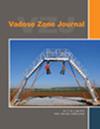aquitard中的稀有气体提供了对下伏地下地层和自由气体形成的深入了解
IF 2.5
3区 地球科学
Q3 ENVIRONMENTAL SCIENCES
引用次数: 1
摘要
生物地球化学产气导致自由气相形成,严重影响地下水和含水层溶质运移。这种气-水相互作用在受地球成因砷影响的含水层中很重要,这通常与生物地球化学CH4的产生有关。此外,含水层对受污染含水层中砷浓度的影响最近受到了挑战。这些观察结果促使我们在砷污染含水层的高CH4 -产气带的非均质含水层上进行分析。研究人员对通过aquitard提取的沉积物岩心进行了惰性气体分析,以评估aquitard对下部产气的物理贡献。结果表明,水驱孔隙空间在两个独立的层中是不饱和的,导致悬浮孔隙水受到类空气气相的约束。这种非饱和带和饱和带的夹层表明,含水层的地层是决定静水压力的关键,静水压力是下伏含水层中游离气形成(即CH4)的主要控制因素。部分非饱和条件下的静水压力比完全饱和条件下降低30%。据我们所知,这是第一次应用稀有气体来检验含水层物理状态对下伏含水层产气的影响。此外,这种低电导率的部分非饱和沉积层可能为周期性水流提供了优先途径,促进了含水层-含水层溶质的运移。在整个研究地点额外收集的地下水样本证实了比以前报道的更广泛的脱气现象。高达90%的预期大气惰性气体浓度从地下水中流失,而地下水正好位于被调查的沉积物核心下方。本文章由计算机程序翻译,如有差异,请以英文原文为准。
Noble gases in aquitard provide insight into underlying subsurface stratigraphy and free gas formation
Biogeochemical gas production resulting in free gas phase formation can severely affect groundwater and solute transport in aquifers. Such gas–water interactions are important in aquifers affected by geogenic As, which are commonly associated with biogeochemical CH4 production. Additionally, the influence of aquitards on As concentrations in contaminated aquifers has recently been challenged. These observations prompted the analysis through a heterogeneous aquitard overlying a high CH4−gas‐producing zone of an As‐contaminated aquifer. A sediment core taken through the aquitard was analyzed for noble gases to assess how the aquitard physically contributes to the underlying gas production. Results reveal that the aquitard pore space is unsaturated in two separate layers resulting in hanging pore water constrained by an air‐like gas phase. This interlayering of unsaturated and saturated zones identifies the aquitard's stratigraphy as key in determining hydrostatic pressure—a main control of free gas formation (i.e., CH4) in the underlying aquifer. The partly unsaturated conditions reduce the hydrostatic pressure by 30% compared with fully saturated conditions. To our knowledge, this is the first study applying noble gases to examine the influence of an aquitards physical state on gas production in an underlying aquifer. Further, such partly unsaturated sediment layers of low conductivity might provide preferential pathways for periodic water flow, fostering aquitard–aquifer solute transport. Groundwater samples additionally collected throughout the study site confirm more widespread degassing than previously reported. Up to 90% of the expected atmospheric noble gas concentrations is lost from groundwater immediately below the investigated sediment core.
求助全文
通过发布文献求助,成功后即可免费获取论文全文。
去求助
来源期刊

Vadose Zone Journal
环境科学-环境科学
CiteScore
5.60
自引率
7.10%
发文量
61
审稿时长
3.8 months
期刊介绍:
Vadose Zone Journal is a unique publication outlet for interdisciplinary research and assessment of the vadose zone, the portion of the Critical Zone that comprises the Earth’s critical living surface down to groundwater. It is a peer-reviewed, international journal publishing reviews, original research, and special sections across a wide range of disciplines. Vadose Zone Journal reports fundamental and applied research from disciplinary and multidisciplinary investigations, including assessment and policy analyses, of the mostly unsaturated zone between the soil surface and the groundwater table. The goal is to disseminate information to facilitate science-based decision-making and sustainable management of the vadose zone. Examples of topic areas suitable for VZJ are variably saturated fluid flow, heat and solute transport in granular and fractured media, flow processes in the capillary fringe at or near the water table, water table management, regional and global climate change impacts on the vadose zone, carbon sequestration, design and performance of waste disposal facilities, long-term stewardship of contaminated sites in the vadose zone, biogeochemical transformation processes, microbial processes in shallow and deep formations, bioremediation, and the fate and transport of radionuclides, inorganic and organic chemicals, colloids, viruses, and microorganisms. Articles in VZJ also address yet-to-be-resolved issues, such as how to quantify heterogeneity of subsurface processes and properties, and how to couple physical, chemical, and biological processes across a range of spatial scales from the molecular to the global.
 求助内容:
求助内容: 应助结果提醒方式:
应助结果提醒方式:


